Gluu OAuth PEP#
Overview#
The OAuth PEP is used to enforce the presence of OAuth scopes for access to resources protected by the Gateway. OAuth scopes are defined in an external OAuth Authorization Server (AS) -- in most cases the Gluu Server. The Gateway and AS leverage the oxd OAuth middleware service for communication.
The plugin supports two types of tokens:
- Default Access Token: The plugin will authenticate the token using introspection.
- Access Token as JWT: The plugin will authenticate the token using JWT to verify. Currently the plugin supports three algorithms: RS256, RS384 and RS512.
Configuration#
Plugins can be configured at the Service, Route or Global level. There are several possibilities for plugin configuration with services and routes. For information on plugin precedence, read the Kong docs.
Important
During plugin configuration, the GG UI creates a new OP Client if the oxd ID is left blank. However, if configuring with the Kong Admin API, existing client credentials must be used.
Important
konga.log also shows the curl commands for all API requests to Kong and oxd made by the Konga GUI. This curl command can be used to automate configuration instead of using the web interface.
Service Level#
Add a Service using GG UI#
Use the Service section of the GG UI doc to add a service using GG UI.
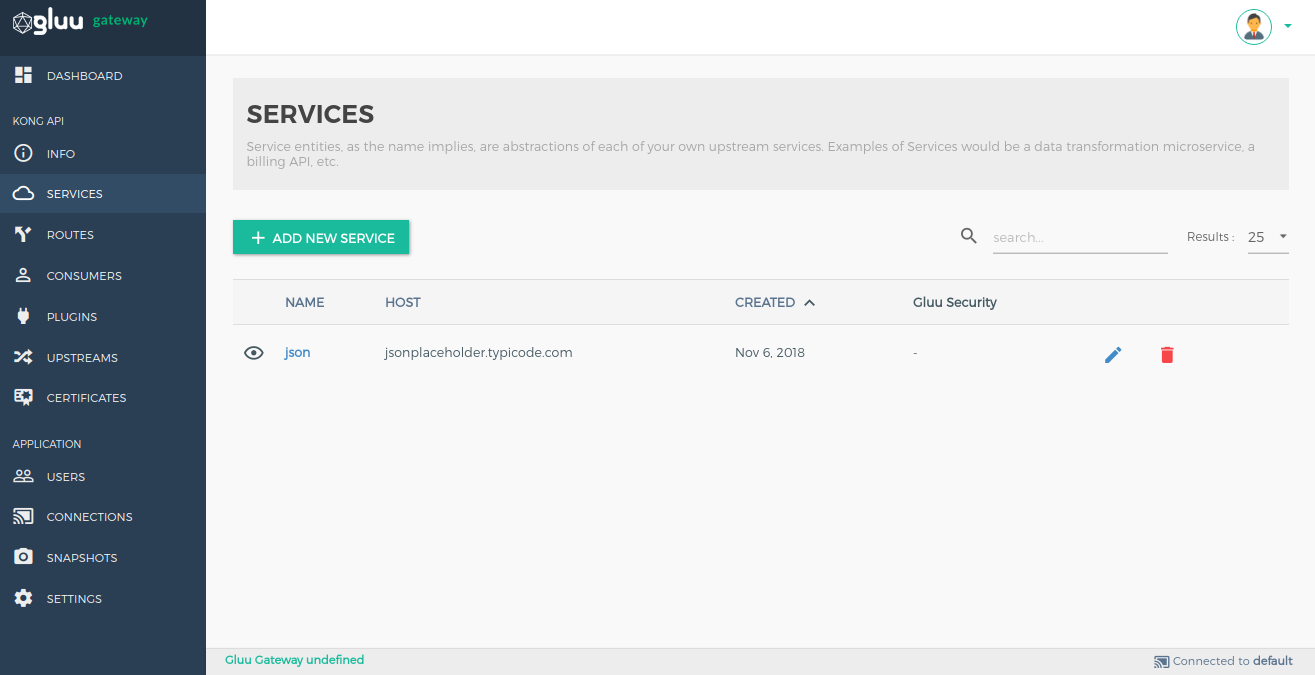
Add a Service using Kong Admin API#
$ curl -X POST \
http://<kong_hostname>:8001/services \
-H 'Content-Type: application/json' \
-d '{
"name": "<service_name>",
"url": "http://upstream-api-url.com"
}'
Configure Service Plugin using GG UI#
Use the Manage Service section in the GG UI to enable the Gluu OAuth PEP plugin. In the security category, there is a Gluu OAuth PEP box. Click on the + icon to enable the plugin.

Clicking on the + icon will bring up the below form.

Configure a Service Plugin using Kong Admin API#
$ curl -X POST \
http://<kong_hostname>:8001/plugins \
-H 'Content-Type: application/json' \
-d '{
"name": "gluu-oauth-pep",
"config": {
"oxd_url": "<your_oxd_server_url>",
"op_url": "<your_op_server_url>",
"oxd_id": "<oxd_id>",
"client_id": "<client_id>",
"client_secret": "<client_secret>",
"oauth_scope_expression": [
{
"path": "/posts",
"conditions": [
{
"httpMethods": [
"GET"
],
"scope_expression": {
"rule": {
"and": [
{
"var": 0
},
{
"var": 1
}
]
},
"data": [
"admin",
"employee"
]
}
}
]
}
],
"ignore_scope": <false|true>,
"deny_by_default": <false|true>,
"hide_credentials": <false|true>
},
"service_id": "<kong_service_object_id>"
}'
Note
Kong does not allow proxying using only a service object--this feature requires a route. At minimum, one service is needed to register an Upstream API and one route is needed for proxying.
Route Level#
Add a Route using GG UI#
Use the Manage Service Section to add a route using the GG UI.
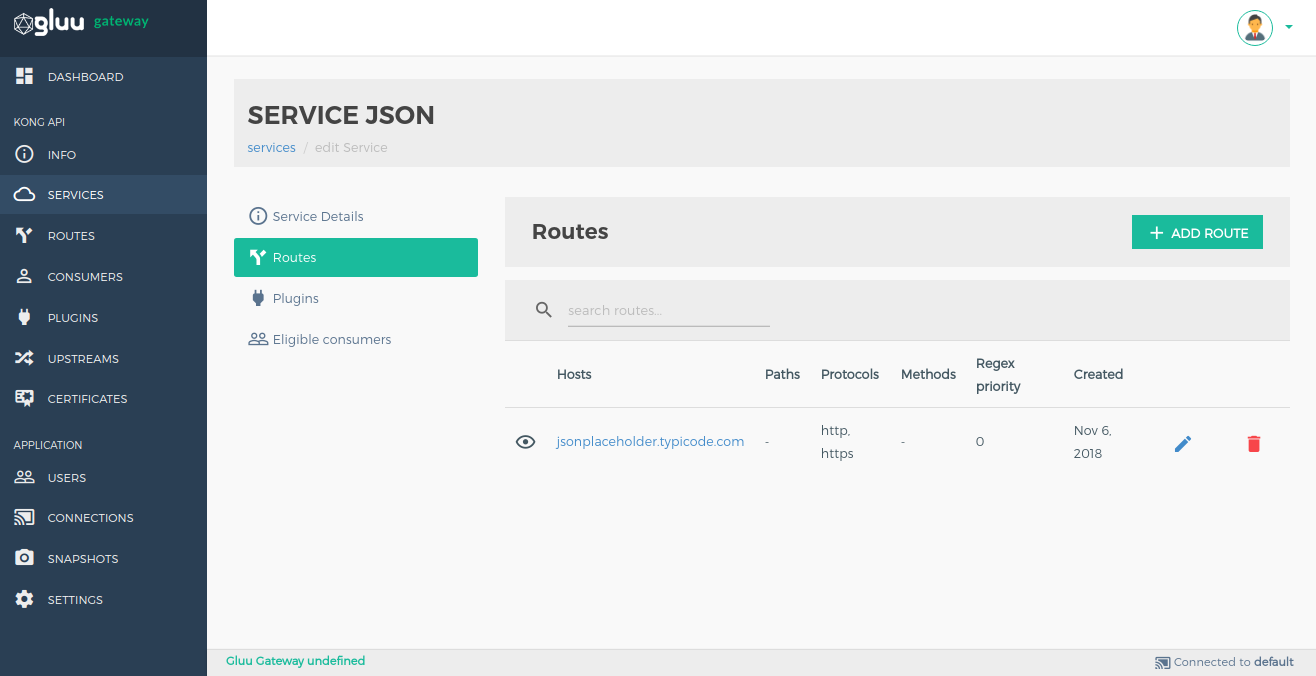
Add a Route using Kong Admin API#
$ curl -X POST \
http://<kong_hostname>:8001/routes \
-H 'Content-Type: application/json' \
-d '{
"hosts": [
"<your_host.com>"
],
"service": {
"id": "<kong_service_object_id>"
}
}'
Information
There are several possibilities for what to put in the hosts field. One technique is to send the request to a proxy. See more information and possibilities in the Proxy reference Kong Documents.
Configure a Route Plugin using GG UI#
Use the Manage Route section in the GG UI to enable the Gluu OAuth PEP plugin. In the security category, there is a Gluu OAuth PEP box. Click on the + icon to enable the plugin.
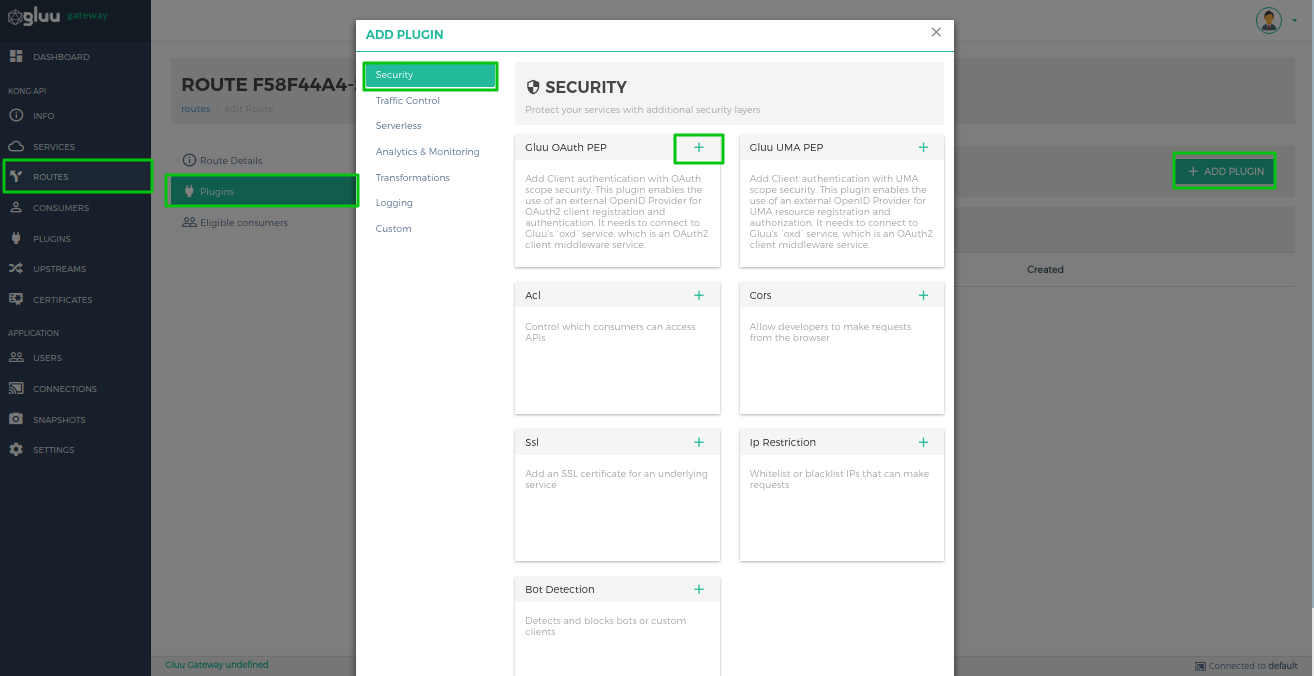
Clicking on the + icon will bring up the below form.
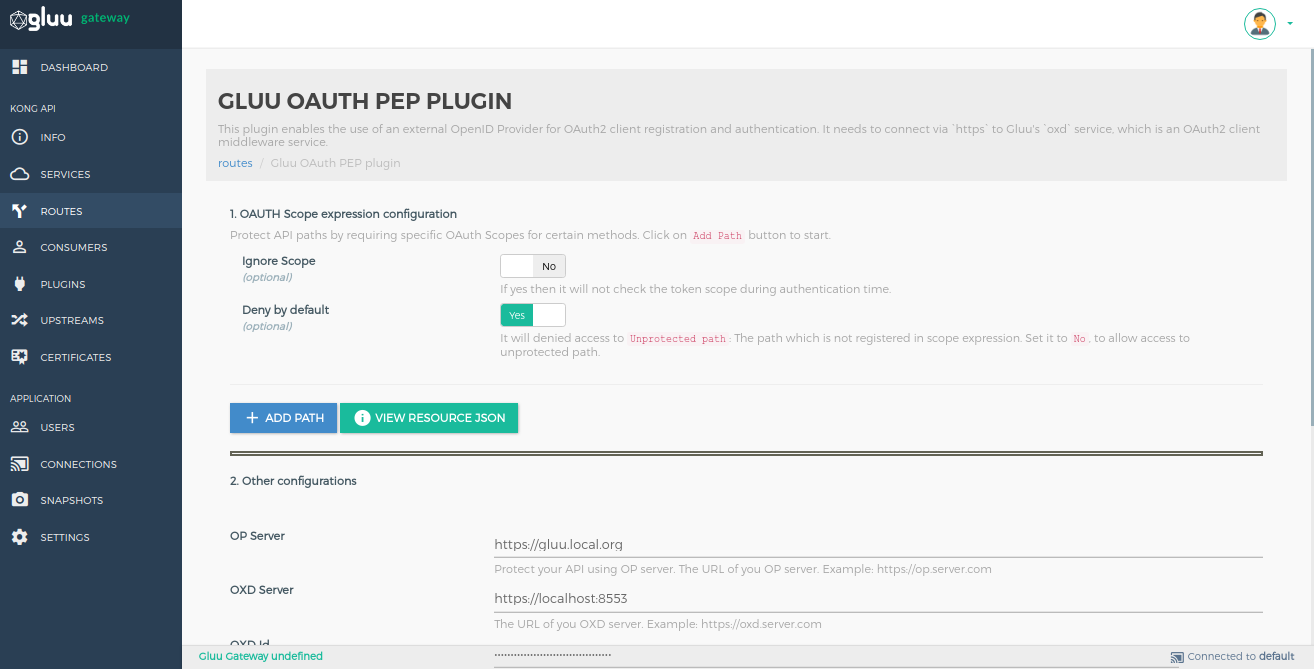
Configure Route Plugin using Kong Admin API#
$ curl -X POST \
http://<kong_hostname>:8001/plugins \
-H 'Content-Type: application/json' \
-d '{
"name": "gluu-oauth-pep",
"config": {
"oxd_url": "<your_oxd_server_url>",
"op_url": "<your_op_server_url>",
"oxd_id": "<oxd_id>",
"client_id": "<client_id>",
"client_secret": "<client_secret>",
"oauth_scope_expression": [
{
"path": "/posts",
"conditions": [
{
"httpMethods": [
"GET"
],
"scope_expression": {
"rule": {
"and": [
{
"var": 0
},
{
"var": 1
}
]
},
"data": [
"admin",
"employee"
]
}
}
]
}
],
"ignore_scope": <false|true>,
"deny_by_default": <false|true>,
"hide_credentials": <false|true>
},
"route_id": "<kong_route_object_id>"
}'
Global Plugin#
A global plugin will apply to all services and routes.
Configure a Global Plugin using GG UI#
Use the Plugin section in the GG UI to enable the Gluu OAuth PEP plugin. In the security category, there is a Gluu OAuth PEP box. Click on the + icon to enable the plugin.

Clicking on the + icon will bring up the below form.

Configure a Global Plugin using Kong Admin API#
$ curl -X POST \
http://<kong_hostname>:8001/plugins \
-H 'Content-Type: application/json' \
-d '{
"name": "gluu-oauth-pep",
"config": {
"oxd_url": "<your_oxd_server_url>",
"op_url": "<your_op_server_url>",
"oxd_id": "<oxd_id>",
"client_id": "<client_id>",
"client_secret": "<client_secret>",
"oauth_scope_expression": [
{
"path": "/posts",
"conditions": [
{
"httpMethods": [
"GET"
],
"scope_expression": {
"rule": {
"and": [
{
"var": 0
},
{
"var": 1
}
]
},
"data": [
"admin",
"employee"
]
}
}
]
}
],
"ignore_scope": <false|true>,
"deny_by_default": <false|true>,
"hide_credentials": <false|true>
}
}'
Parameters#
The following parameters can be used in this plugin's configuration.
| field | Default | Description |
|---|---|---|
| op_url | The URL of your OP server. Example: https://op.server.com | |
| oxd_url | The URL of your oxd server. Example: https://oxd.server.com | |
| oxd_id | The ID for an existing client, used to introspect the token. If left blank, a new client will be registered dynamically | |
| client_id | An existing client ID, used to get a protection access token to access the introspection API. Required if an existing oxd ID is provided. | |
| client_secret | An existing client secret, used to get protection access token to access the introspection API. Required if an existing oxd ID is provided. | |
| oauth_scope_expression | Used to add scope security on an OAuth scope token. | |
| ignore_scope | false | If true, will not check any token scopes while authenticating. |
| deny_by_default | true | For paths not protected by OAuth scope expressions. If true, denies unprotected paths. |
| anonymous | An optional string (consumer UUID) value to use as an “anonymous” consumer if authentication fails. If empty (default), the request will fail with an authentication failure 4xx. This value must refer to the Consumer ID attribute that is internal to Kong, and not its custom_id. | |
| hide_credentials | false | An optional boolean value telling the plugin to show or hide the credential from the upstream service. If true, the plugin will strip the credential from the request (i.e. the Authorization header) before proxying it. |
Note
GG UI can create a dynamic client. However, if the Kong Admin API is used for plugin configuration, it requires an existing client using the oxd API, then passing the client's credentials to the Gluu-OAuth-PEP plugin.
OAuth Scope Expression#
The OAuth Scope Expression is a JSON expression, providing security for OAuth scopes. It checks the scope (from token introspection) of the token with the configured OAuth JSON expression.
Note
Enable and disable the OAuth scope expression by setting ignore_scope to true.
For example, to protect an API:
[
{
"path": "/images",
"conditions": [
{
"httpMethods": [
"GET"
],
"scope_expression": {
"rule": {
"and": [
{
"var": 0
},
{
"or": [
{
"var": 1
},
{
"var": 2
}
]
}
]
},
"data": [
"openid",
"email",
"clientinfo"
]
}
}
]
}
]
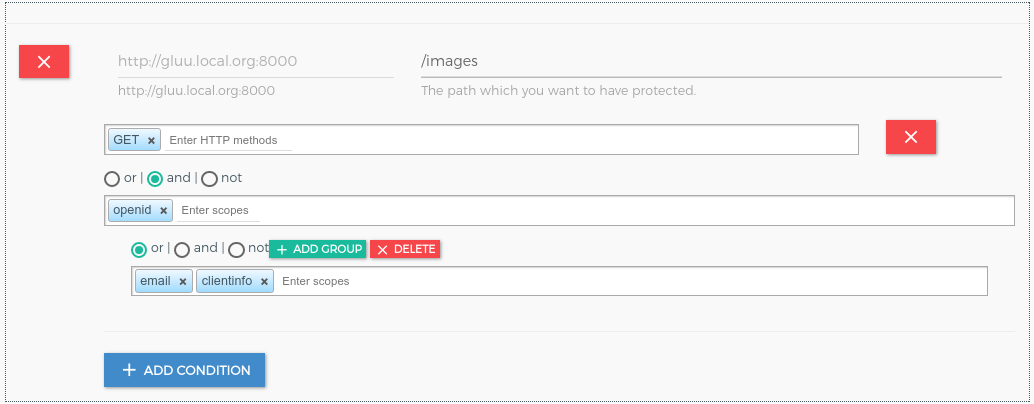
At runtime, the plugin matches the scope expression with token scopes. The inner expression is executed first, matching the scopes from the expression one by one with the requested scope. For each match,true is returned. If a check does not match, it returns false.
Example 1: For a token with the ["clientinfo"] scope only.
The values of data will convert into Boolean values. If the token scope matches the expression scope, return true. If not, return false.
["openid","email","clientinfo"] --> [false, false, true]
Check the result using http://jsonlogic.com.
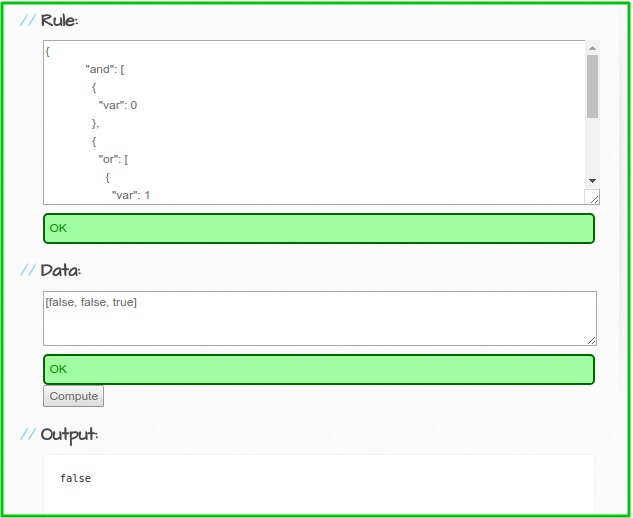
The result is false, so the request is not allowed.
Example 2: For a token with ["openid", "clientinfo"] scopes.
The data value is
["openid","email","clientinfo"] --> [true, false, true]
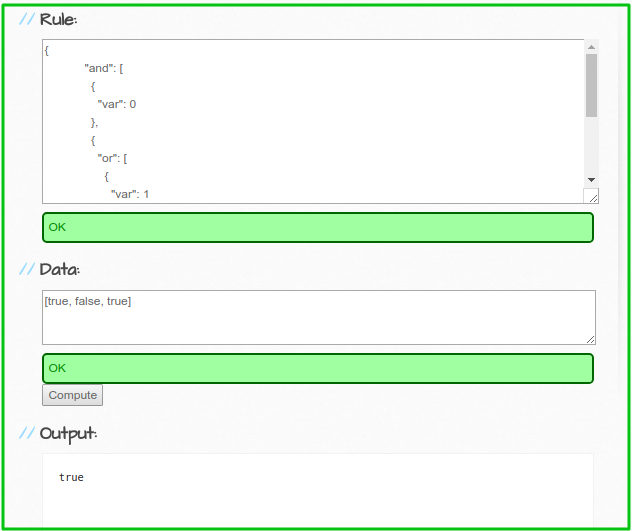
The result is true, so the request is allowed.
Dynamic Resource Protection#
To protect a dynamic resource with UMA or OAuth scopes, secure the parent path. For example, securing folder with a chosen scope will secure both /folder and /folder/[id]. Any protection on the parent will be applied to its children, unless different protection is explicitly defined.
Example use cases for different resource security rules:
-
Rule1 for path GET /root
{scope: a and b} -
Rule2 for path GET /root/folder1
{scope: c} -
Rule3 for path GET /root/folder1/folder2
{scope: d}
GET /root --> Apply Rule1
GET /root/1 --> Apply Rule1
GET /root/one --> Apply Rule1
GET /root/one/two --> Apply Rule1
GET /root/two?id=df4edfdf --> Apply Rule1
GET /root/folder1 --> Apply Rule2
GET /root/folder1/1 --> Apply Rule2
GET /root/folder1?id=dfdf454gtfg --> Apply Rule2
GET /root/folder1/one/two --> Apply Rule2
GET /root/folder1/one/two/treww?id=w4354f --> Apply Rule2
GET /root/folder1/folder2/1 --> Apply Rule3
GET /root/folder1/folder2/one/two --> Apply Rule3
GET /root/folder1/folder2/dsd545df --> Apply Rule3
GET /root/folder1/folder2/one?id=fdfdf --> Apply Rule3
Usage#
Create Client#
Create a client using the create client consumer section. Use the oxd register-site API to create a client.
Create Consumer#
A client credential needs to be associated with an existing Consumer object. To create a Consumer, use the Consumer section.
Create a consumer using the Kong Admin API:
$ curl -X POST \
http://<kong_hostname>:8001/consumers \
-H 'Content-Type: application/json' \
-d '{
"username": "<kong_consumer_name>",
"custom_id": "<gluu_client_id>"
}'
Security & Access Proxy#
To access a proxy upstream API, pass an OAuth token in the authorization header. Generate the OAuth token using OP Client credentials by sending a request to the oxd /get-client-token API.
For example, to access a Kong proxy using an OAuth token:
curl -X GET \
http://<kong_hostname>:8000/{path matching a configured Route} \
-H 'Authorization: Bearer <oauth_token>' \
Note
Kong normally provides the 8443 port for https by default, but during the setup script installation, it is changed to 443.
Upstream Headers#
When a client has been authenticated, the plugin will append some headers to the request before proxying it to the upstream service to identify the consumer and the end user in the code:
- X-Consumer-ID, the ID of the Consumer on Kong
- X-Consumer-Custom-ID, the custom_id of the Consumer (if set)
- X-Consumer-Username, the username of the Consumer (if set)
- X-Authenticated-Scope, the comma-separated list of scopes that the end user has authenticated, if available (only if the consumer is not an 'anonymous' consumer)
- X-OAuth-Client-ID, the authenticated client ID (only if the consumer is not an 'anonymous' consumer)
- X-OAuth-Expiration, the token expiration time, integer timestamp, measured in the number of seconds since January 1, 1970 UTC, indicating when this token will expire, as defined in JWT RFC7519. It is only returned if the consumer is not set to 'anonymous'.
- X-Anonymous-Consumer, will be set to true when authentication fails, and the 'anonymous' consumer is set instead.
This information can be used to implement additional logic. For example, use the X-Consumer-ID value to query the Kong Admin API and retrieve more information about the Consumer.